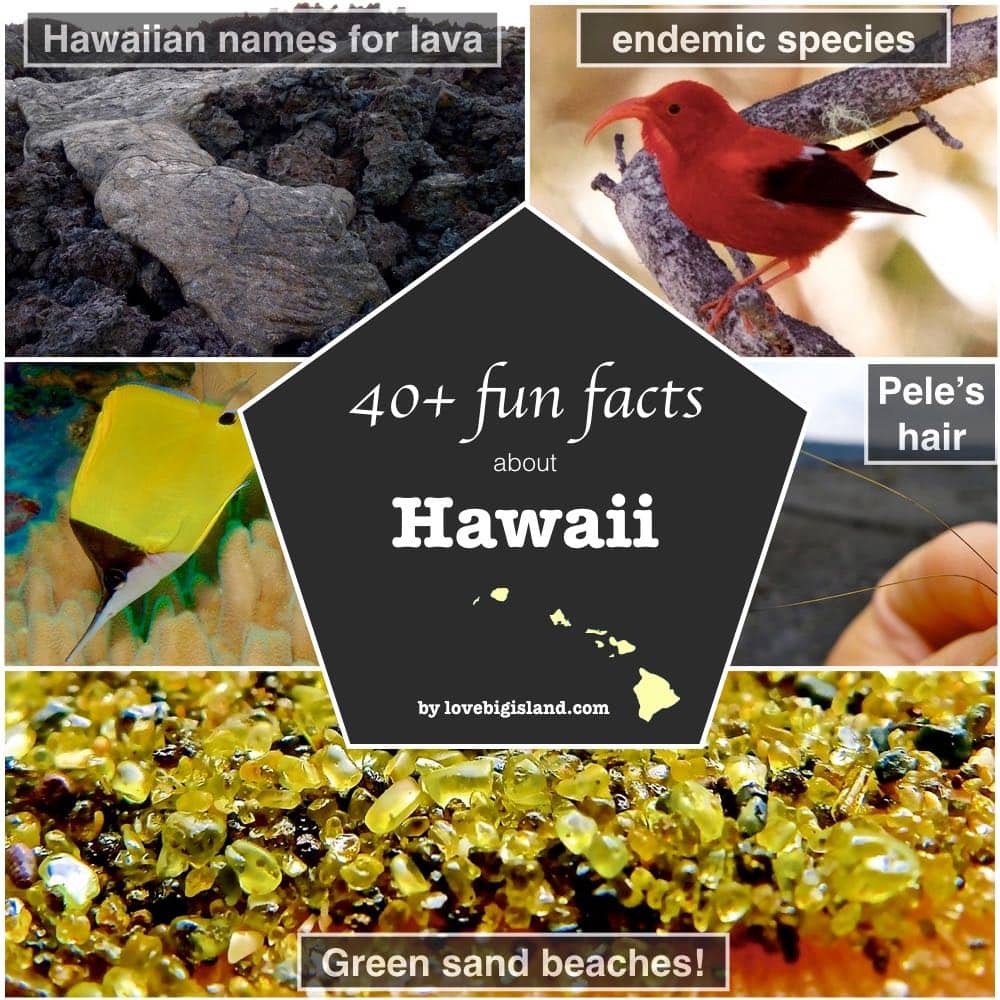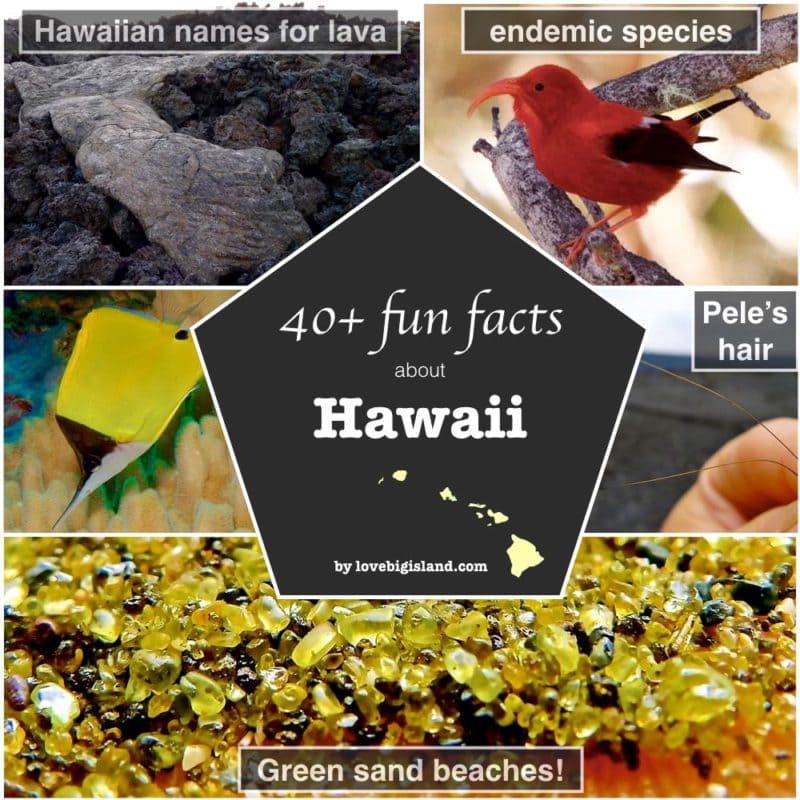Fact sheet of the Big Island of Hawaii. Learn about Hawaii and surprise your friends with the fun facts and trivia we have collected on the Big Island.
40+ Big Island Facts and Trivia. Learn fun stuff!
- Aloha!
- Aloha shirts
- Aloha state
- Antipodes
- Air Strikes on Hawaii
- Beaches
- Captain Cook
- Earthquakes on Hawaii
- Endangered birds
- Endemic species on Hawaii
- Green sand beach
- Hāpuʻu (Hawaiian tree fern)
- Hawaii island flower
- Hawaii nicknames
- Hawaii state bird
- Hawaiian alphabet
- Humuhumunukunukuāpuaʻa
- Ironman triathlon
- Kahili ginger
- Kailua
- Kama‘ehuakanaloa – the youngest island of Hawaii
- Kilauea
- Lake Waiau
- Lava flow speed record
- Loco moco
- lauwiliwilinukunukuʻoiʻoi
- Longest river
- Ma Uka and Ma Kai
- Mahukona Volcano
- Meteors in Hawaiian Culture
- Not so big Big Island
- Pahoehoe and Aʻa
- Pidgin – the unofficial language of Hawaii
- Pele’s hair
- Pineapples
- Recent lava damage
- Sandwich Islands
- Spam
- Telescopes on Hawaii
- The 1946 Tsunami
- The widest state!
- 24 Tsunamis since 1812
- Two ladies kitchen
- Ukulele
- Waipiʻo cliffs
- Wiki
- World records for Hawaii
Some of the nuggets of trivia listed above are so interesting that we decided they deserve their own comprehensive article. You can see that list below:
The Lauwiliwilinukunukuʻoiʻoi
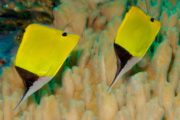
Endemic and Native Species in Hawaii
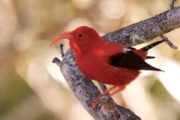
Lake Waiau on MaunaKea: the highest elevation lake on Hawaiʻi
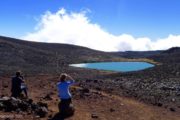
Pāhoehoe and ʻAʻā Lava
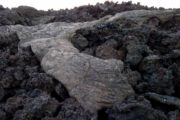
Pineapples in Hawaiʻi: 🍍history, 🍍facts, and 🍍trivia
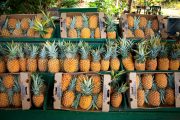
Hāpuʻu or Hawaiian tree fern [trivia]
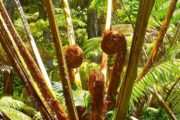
Green Sand Beach [trivia]
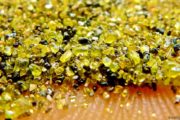
Kahili Ginger
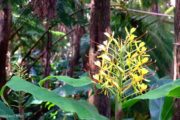
The antipodes of Hawaii
Pele’s Hair (volcanic glass)
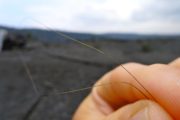
Big Island Fact Sheet
Aloha!
Aloha means many things, including: love, affection, compassion, mercy, sympathy, pity, kindness, sentiment, grace, charity, greeting, salutation, regards, sweetheart, lover, loved one, to love, to be fond of, and many more things. It is commonly used as a greeting or a way to say goodbye.
Are you here for Spam? You must be from Hawaii, we love that stuff! (click the spam-url for more spam trivia).
Aloha Shirts
The aloha shirt, a shirt with exotic designs, became fashionable in the world in the 1980s. These Hawaiian shirts were worn by superstars such as Richard Gere, Bob Barker, Timothy Hutton, Jack Nicholson, and Paul Newman.
Aloha State
Hawaii is the 50th state of the USA. By a legislative act, Hawaii became officially known as the “Aloha State” in 1959.
Antipodes
An antipode is a person that lives on exactly the other side of the planet. The antipodes for all Hawaiians except those living in the north of Kauai are people living in the country of Botswana in Africa (see the pictures to convince yourself). The antipodes for people living in the northern part of Kauai are Namibians (from Namibia).
Air Strikes on Hawaiʻi
The air force bombed a lava flow that threatened Hilo in 1935 but failed to stop it. Read more Hawaiian facts and trivia about the volcanoes in A Short History of the Big Island in 5 Volcanoes.
Always close to a beach!
While on the Big Island you will never be farther than 28.5 miles away from a beach. Better yet, 30% of the surface of the Big Island is within 5 miles of a beach! (source).
Captain Cook
Did You know that the famous British explorer Captain James Cook died on the Big Island during a struggle with the native population? This happened in Kealakekua Bay (also nicknamed Captain Cook) in 1779 A.D.
Nowadays, Kealakekua Bay is a favorite destination for snorkeling and diving on the Big Island that should not be missed.
Earthquakes on Hawaiʻi
Hawaii is not the state with most earthquakes, but it is the state with the highest earthquake density! The Big Island is by far the most seismically active island of all Hawaiian islands. Read more in “Hawaii, the Earthquake state?”
Endangered Birds
More birds have become extinct in Hawaii than in any other part of the world. A total of 26 species died out and 27 more are endangered by changes in their natural habitats, forest destruction, rats, mongooses, and of course human kind.
Endemic species on Hawaii
Endemic to Hawaiʻi means that you cannot find it at any other place in the world. 90% of all native species on Hawaii are endemic if you only count the native species that live on land. 50% of *all native* species on Hawaii are endemic, and 40% of *all* species are endemic. Pretty cool!
Read more of such cool facts (e.g. 99.5% of tree snails are endemic!) in our comprehensive guide to native and endemic species on Hawaii.
Green Sand Beach
Green sand beach is one of the two green sand beaches in the United States, and one of the 4 green sand beaches worldwide! It gets its color (and name) from olivine crystals that wash out of a 49.000-year-old cinder cone next to the beach.
Other names for this beach are Papakolea and Mahana beach. Find out why on our dedicated Green sand beach trivia page.
Hāpuʻu or Hawaiian tree fern
The Hāpuʻu or Hawaiian tree fern (Cibotium menziesii) is what gives many places on Hawaii that “Jurassic park” feel. It also has medicinal use and features in a Hawaiian proverb about famine and death.
Curious? Find out more at our dedicated “Hāpuʻu trivia” page.
Hawaii Island Flower
Island flowers and colors are used to represent each island. The Island Flower of the Big Island is called the “Pua Lehua”. It is the red blossom of the ōhiʻa lehua tree and is intimately connected to an interesting Hawaiian legend.
The mother tree of the lehua flower, Ōhiʻa Lehua, is the State Endemic Tree.
Nicknames for the Big Island
The Island of Hawaiʻi is the official name for the Big Island, but it gets even more confusing! If you hear people about the following islands, they all talk about the same island.
- “The island of Hawaiʻi”
- “The Big Island”
- “The Orchid Island”
- “Hawaiʻi’s Island of Adventure”
Hawaii State Bird
The Hawaiian Goose or Nēnē (Branta sandvicensis) is a species of goose endemic to the Hawaiian Islands. It is the official state bird of Hawaiʻi and is exclusively found in the wild on the islands of Maui, Kauaʻi and Hawaiʻi. The Hawaiian name Nēnē comes from its soft call.
Hawaiian Alphabet
Together with English, Hawaiian is an official languages of the state. Two important parts of the Hawaiian language unbeknownst to many visitors are the ‘okina (which represents a glottal stop – a consonant) and the kahakō (a macron used to indicate long vowels).
The Hawaiian pī‘āpā (alphabet) consists of 13 letters:
- 5 normal vowels: A (‘ā), E (‘ē), I (‘ī), O (‘ō), U (‘ū),
- 8 consonants: H (hē), K (kē), L (lā), M (mū), N (nū), P (pī), W (wē), ‘ (‘okina)
Despite this limited amount of letters, Hawaiian know some proper tongue-twisters, such as the state fish called “humuhumunukunukuāpuaʻa” or the lauwiliwilinukunukuʻoiʻoi.
Good to know: The ‘okina and the kahakō distinguish many words, and without this orthography, word definitions change. For example: ono (a fish) is different from ‘ono (delicious), and kau (to place) is different from kāu (your).
Humuhumunukunukuāpuaʻa
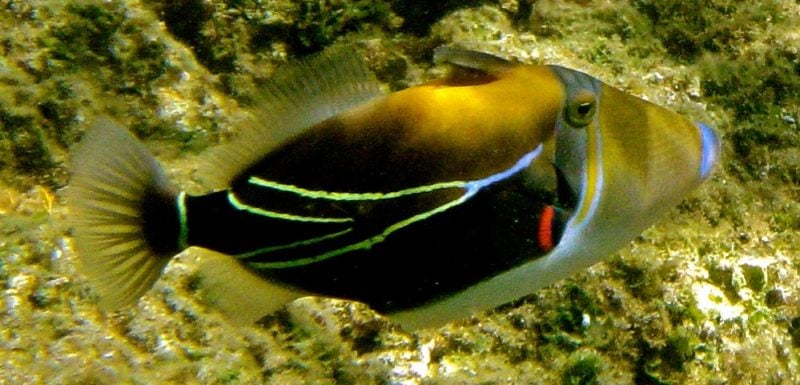
Humuhumunukunukuāpuaʻa (reef trigger fish), the state fish of the Big Island of Hawaii
The state fish of Hawaii is the humuhumunukunukuāpuaʻa. Translated from Hawaiian it means “triggerfish with a pig-like short snout”. It’s name is pronounced as “who-moo-who-moo-noo-koo-noo-koo-ah-pooah-ah”.
The humuhumunukunukuāpuaʻa has not, as often claimed, the longest fish name in Hawaiian. That distinction belongs to lauwiliwilinukunukuʻoiʻoi (“long-snouted fish shaped like a wiliwili leaf”).
Ironman Triathlon
The Ironman Triathlon was moved from Oahu to the Big Island in 1981. It runs now between Kona in the East and Hawi in the North.
Kahili Ginger
Kahili ginger is very pretty and an invasive species originating from eastern India. ‘Kahili’ is a Hawaiian word for a feather standard or a long pole decorated at one end with a cluster of feather plumes, which is a symbol of royalty and is/was used as a ceremonial emblem in Hawaii.
[more information and pictures of Kahili Ginger]
This plant is probably one of the first to catch your eye if you are visiting Volcano Village or the Hawaii Volcanoes National Park, but can be found in forests on all Hawaiian islands.
Kailua
Kailua means “two seas” or “two currents”. It is a contraction of the words kai (meaning “sea” or “sea water”) and ʻelua (meaning “two”). There are two cities on the Hawaiian islands called ‘Kailua’. The biggest Kailua is on the windward side of Oʻahu, while the smaller lies on the leeward side of the Big Island. Because in the Hawaiian language, ‘leeward’ means ‘kona’, Kailua on the Big Island is also referred to as ‘Kailua-Kona‘.
Kama‘ehuakanaloa
The Big Island is the youngest Island of Hawaii, but that will change in the future! As the island moves away from the hot spot responsible for the Hawaiian Islands, a new Island is already forming 15 miles southeast of the coast of Big Island: Kama‘ehuakanaloa (formerly know as Loihi). The summit of Kama‘ehuakanaloa has already risen by two miles, and it still has one mile to go until it breaks the ocean surface. In another 30 or 40 thousand years, Kama‘ehuakanaloa will be born as the youngest of the Hawaiian Islands!
Kilauea
The Kilauea Volcano is one of the most active volcanoes in the world – and it has been active for a long time! The Hawaiian name “Kīlauea” means “spewing” or “much spreading,” probably in reference to the lava flows that it already erupted in ancient Hawaiian times.
Lake Waiau
Just below the summit of MaunaKea, inside a cinder cone, is Lake Waiau. This is the only glacial lake in the mid-Pacific, and, at 13,020 feet above sea level, it is also one of the higher lakes in the world. In recent years its volume is fluctuating a lot. By November 2013 it held less than 1%(!) compared to its pre-2010 volume [source 1], while as per mid-2015 it refilled almost back to historic levels [source 2].
You can find more in-depth information on, and pictures of, lake Waiau, at our dedicated Lake Waiau Trivia page.
Lava flow speed record (for the flow front)
Like many other things, lava flows on Hawaiʻi have their own pace. The fastest recorded flow recorded here was the 1950 Hoʻokena ʻaʻa flow of Mauna Loa which advanced down a 5º slope through thick forest at approximately 10 km (6 miles)/hour [source].
This speed record is for the front of the lava flow. Once a lava flow is established it creates a channel of fast flowing lava contained within a lava tube or an open lava river. Lava flows in these rivers can reach speeds far above to above mentioned record – see for example the following video made during the destructive Kilauea 2018 lower East Rift Zone eruption by local photographer Ken Boyer:
Lauwiliwilinukunukuʻoiʻoi
The fish with the honor of having the longest Hawaiian name is the lauwiliwilinukunukuʻoiʻoi. Freely translated this name means “long-snouted fish shaped like a wiliwili leaf”. This fish indeed has a HUGE snout, and is also monogamous!
You can find out more about this interesting fish and tongue twister extraordinaire in our extended lauwiliwilinukunukuʻoiʻoi trivia article.
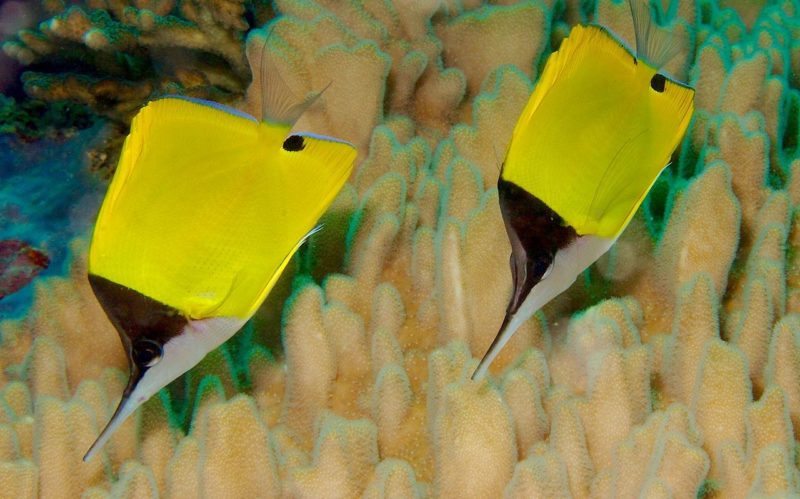
Forcipiger flavissimus Yellow Longnose Butterflyfish. Source: Wikimedia commons by user Nhobgood. Published under a CC BY-SA 3.0 license
Loco Moco
The Loco Moco is a dish native to Hawaii. It consists of white rice topped with a hamburger patty, a fried egg, and brown gravy, but there are many variations. These include amongst others: chili, bacon, ham, Spam, kalua pork, Portuguese sausage, teriyaki beef, teriyaki chicken, mahi-mahi, shrimp, oysters, and other meats, Big Island Grinds can tell you more.
Longest river on Hawaiʻi (Kaukonahua Stream on Oʻahu)
The longest river in the state of Hawaiʻi is the Kaukonahua Stream on Oʻahu, which is 33 miles long. The second longest river is the Wailuku River on the Big Island. This river starts high up Maunakea and takes 32 miles to reach the ocean.
The Wailuku river does have the largest water discharge of all rivers in the state, with an average of 180 million gallons / day. This is part of what makes the rainbow falls (on the Wailuku river) such a beautiful waterfall. (source)
The largest navigable river (Wailua river on Kauaʻi)
If you are looking for the largest river that you can explore yourself (e.g. by kayak, SUP or outrigger canoe) you need to head to the Wailua river on Kauaʻi. Flowing from the 5,148-foot Mount Waialeale past gorgeous waterfalls and lush, jungle landscapes along the island’s East Side to the ocean it racks up 20 miles, which makes it 3.5 miles longer than the Hanalei river.
Ma Uka and Ma Kai
In Hawaii, there are two uniquely local words that describe a direction:
- Ma Uka (mow-kah) means on the mountain side in the context of directions.
- Ma Kai (mah-kigh) means on the ocean side in the context of directions.
These words are used very frequently and without a further description in Hawaii. So, now you’ll know when you go what these words mean and you’ll be navigating like a local.
Meteors in Hawaiian Culture
There are several words for a meteor or comet in the Hawaiian Language: Koll, Akualele, Hokulele and Hoku Welowelo. Leiepio means “To fly, as a meteor through the sky”. You can learn more about Meteors in Hawaiian culture here.
Mahukona Volcano
The Mahukona volcano is the oldest and the northernmost volcano of the Big Island of Hawaii. Its existence was predicted in 1890 but it took scientists up to 1987 (almost 100 years!) to confirm this. You can read more about the Mahukona volcano (and the 5 other volcanoes that are, have been or will be part of the big island) on our Big Island Blog.
How “Big” is the Big Island?
The Big Island might be “big” compared to the other Hawaiian islands, but, in reality, it is quite small. From the southern tip to the northern tip it measures a mere 93 miles, while the distance between the extreme points on the east side and the west side is 76 miles (source). The surface of the Big Island is 4,029 square miles (10,433 km2).
Pahoehoe and A’a
There are two different kinds of hardened lava you can encounter on the Big Island: Pahoehoe (pronounced ‘pah hoy hoy’) and a’a (pronounced ‘ah ah’). The surface of a’a lava is very sharp and rough, while pahoehoe lava surfaces are more smooth.
Pictures, a video, and more information in our in-depth Pahoehoe and A’a article.
Pele’s Hair
Pele’s hair is not real hair from the Hawaiian goddess of fire Pele. Instead, it is the internationally recognized name for little strands of lava glass that are created during ongoing eruptions. Read more about Pele’s hairs (including picture).
Pidgin
Pidgin (or Hawaiʻi Creole) originated as a form of communication used between English speaking residents and non-English speaking immigrants in Hawaii. Almost all locals weave pidgin in their everyday (English) conversations, so try keeping your ears open. If you want to look up a couple of phrases, here is a good place to start.
Pineapples in Hawaiʻi
Ask anyone what they think when you say “Pineapple”, and they will almost certainly say “Hawaii”! Pineapples have for long been a symbol of Hawaii, but they do not originate from there. Pineapples are native to South America and made their way to Hawai’i via a detour to Europe sometime between the 16th and 18th century. Read more about the history of pineapples on Hawaii, about how Hawaiian a “pizza Hawaii” is, and at least 5 other pieces of interesting pineapple facts in our special pineapple fact sheet.
Recent Lava Damage
Between 1983 and 1991, lava flows repeatedly invaded communities on Kilauea’s coastal south flank burying eight miles of highway and destroying 181 houses and a visitor center in Hawai`i Volcanoes National Park.
Sandwich Islands
When Captain Cook first landed on the Hawaiian islands in 1778 he named them the Sandwich Islands. Not because he was so happy he could finally get some proper food, but after his Patron, the 4th Earl of Sandwich.
Spam
Spam (the food, not the unsolicited emails) is very popular in Hawaii. More spam is consumed on Hawaii than in any other state of the USA. One popular local snack is “Spam Musubi”.
Because it is so popular here, you can find “exotic” spam versions in supermarkets on Hawaii, such as Honey Spam, Spam with Bacon, and Hot and Spicy Spam. Some people even go as far as calling spam “Hawaiian steak”.
Not us though. We prefer the local, pastured-raised steaks from cows on the Big Island!
Telescopes (and stargazing!) on Hawaiʻi
Mauna Kea on the Big Island houses some of the world’s biggest telescopes and has more scientific observatories in one place than anywhere else in the world.
Read how you can see visit the telescopes on the summit yourself in our DIY stargazing guide for Mauna Kea.
Tsunamis in Hawaiʻi
The state of Hawaiʻi is vulnerable to tsunamis. Since 1812, 24 tsunamis with a run-up of more than 2 meters (6.6 feet) have been recorded.
Of these, the 1946 tsunami (see below) was by far the most devastating. In total, these tsunamis caused 291 casualties, the last ones as recent as in 1975 (source).
Today there are elaborate early warning systems in place to protect against tsunamis.
The 1946 Hilo Tsunami
In 1946, a 54-foot (16.4 meters) tsunami swept over the east side of the Big Island sparking a national tragedy. This tsunami caused 159 deaths and a material damage of 26 million USD (347 million USD in 2017 when corrected for inflation).
If you are in Hilo, you can still see the consequences because the houses closest to the bay have never been rebuild.
The Widest State
If measured from east to west, the state of Hawaii is almost 1500 miles long. This makes Hawaii the widest state of the United States!!
Two Ladies Kitchen
The large Japanese population of Hawaii has a very positive effect on the local food. Have you ever heard of Mochi?
Mochi (little Japanese rice cakes) are now a very popular snack in Hawaii. For one of the best tastes of the Island, go to Two Ladies Kitchen in Hilo and ask for the Strawberry Mochi!
Ukulele
The ukulele was made famous by Hawaiian music (think Israel Kamakawiwoʻole), but is not a native Hawaiian instrument – it is Portuguese! The ukulele came to Hawaii in the 19th century as a Hawaiian interpretation of the “cavaquinho” or “braguinha” and the “rajao”, a small guitar-like instrument taken to Hawaii by Portuguese immigrants.
Waipiʻo Cliffs
The amazing sea-cliffs found on the North of the Big Island (for example at Waipi’o Valley or Pololu) are most likely sculpted by a gigantic landslide some 200.000 years ago when part of the island slid into the sea. These valleys also contain two of our five favorite short hikes on Hawaii!
Wiki
“Wiki” (as in Wikipedia) is a Hawaiian word and means “Quick”.
More World Records for Hawaiʻi
Did you know that Mauna Kea on the Big Island is the tallest sea mountain in the world and, if measured from the ocean bottom, is 4000 feet taller than Mt. Everest? More record-breaking trivia on the Big Island.
